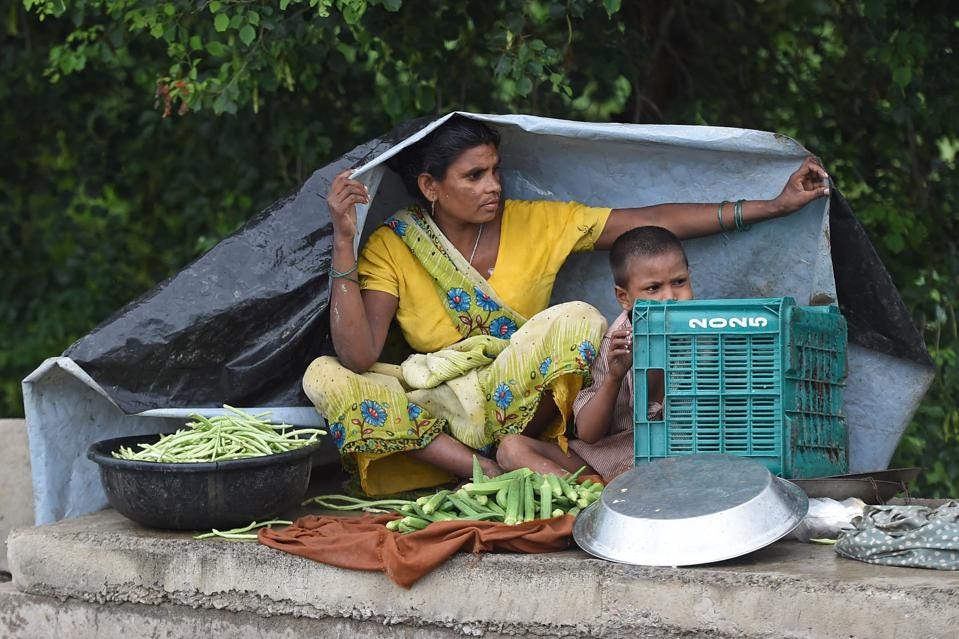
Three out of four women in India do not work as paid employees. Crucially, they do not seek paid employment.
India’s female Labour Force Participation rate – the share of women aged 15-64 who report either as being employed, or being available for work – is 24.8% in 2020. This number is down from 34% in 2006.
A high female labour force participation rate is indicative of a robust economy. In a pandemic-affected world, there are two reasons for this rate to be shamefully low in India.
First, women are busy doing unpaid work at home, including cooking, cleaning and caregiving. Second, women employees populate the informal economy in large numbers. They are paid smaller amounts and in cash, which they do not consider to be ‘work’.
Mamta Sharma, a business executive who lives in a Mumbai suburb, lost her job in April this year after India entered a strict pandemic-induced lockdown.
As an employed woman, her routine was fixed. She woke up at around 6 AM to spend some time with her 2-year-old, cook meals and head to work. The 33-year-old worked in the office between 10 AM and 6 PM with lunch and coffee breaks. Returning home by 7 PM, she had the evening to herself. “Since the lockdown, I have been working 24X7 to run the household,” she said. The difference? No breaks, no pay. Worse, the cooking and cleaning are not considered work, let alone accounting for emotional labour she puts in to run the family of three.
It is well documented that certain tasks are considered ‘feminine’ and hence women are engaged in more unpaid work at home. In India, for every 36 minutes of unpaid care work a man does, a woman does more than six hours.
However, the moot question is, why does Sharma not want to try getting paid employment again? “Because I am certain to not land a job,” she said. There are many people as qualified as she is and there aren’t enough jobs in the market. Even if she got a job, she would be paid much lesser than what she was making, she said.
Women who can afford to stay at home, prefer to do so in a contracting job market.
The pandemic and the subsequent lockdown pushed the Indian economy off the cliff, shrinking the Gross Domestic Product by 23.9% for the April to June quarter. For context, the US’s GDP shrank by 9.1%. For a country whose economy was contracting even before COVID-19 hit, the lockdown was a body blow. The country will not recover from this in a hurry.
India’s unemployment rate hovers around 8%, however the lockdown has moved the jobs significantly into the informal sector, where there are no pay guarantees.
When the Female Labour Force Participation rate is calculated, large parts of the informal economy go unaccounted for. Susheela Kamble, a 27-year-old domestic worker from Dombivali near Mumbai used to clean and cook in three households until April this year. Her services were terminated in all three homes. When asked if she has worked since then, she says no.
However, since April, Kamble has bought a small cane basket full of vegetables from a wholesale merchant every day. Sitting on a pavement near a multi-storied residential complex, she has sold them. “How is this work?” she asked. For her, work was when she got a regular pay every month.
Her customers pay her in cash, in turn, she pays the wholesale merchant in cash. Her contribution to the economy cannot be easily accounted for. Since her 17-year-old daughter takes turns at vegetable vending, Kamble doesn’t consider this ‘work’.
To be sure, women across the world have been disproportionately affected by the pandemic.
Between February and May close to 12 million women lost their jobs as opposed to 9 million men. According to The Guardian, by the end of April, women’s job losses had erased a decade of employment gains.
But, it is time for India to double up and increase the number of women in paid employment in order to catapult its economy back onto the growth track. A 2020 United Nations Global Compact study found that raising women’s participation in the labour force to the same level as men can boost India’s GDP by 27 %.
How many women get paid employment depends on how safe public transport is, how narrow gender pay gap is, access to good childcare and women’s health. It is not difficult to figure where India’s policy priorities should be. But there have been no indications yet that the government is doing anything substantial in this regard.
On Prime Time television news when an economic analyst tried to make a point about the nation’s dipping GDP, the anchor reprimanded him by asking him “not to waste the nation’s and the viewers’ time.”
Published in: Forbes
Published on: September 18 2020
Link: https://www.forbes.com/sites/rakshakumar/2020/09/18/why-indian-women-dont-pursue-paid-employment/?sh=21d044f07fb0
